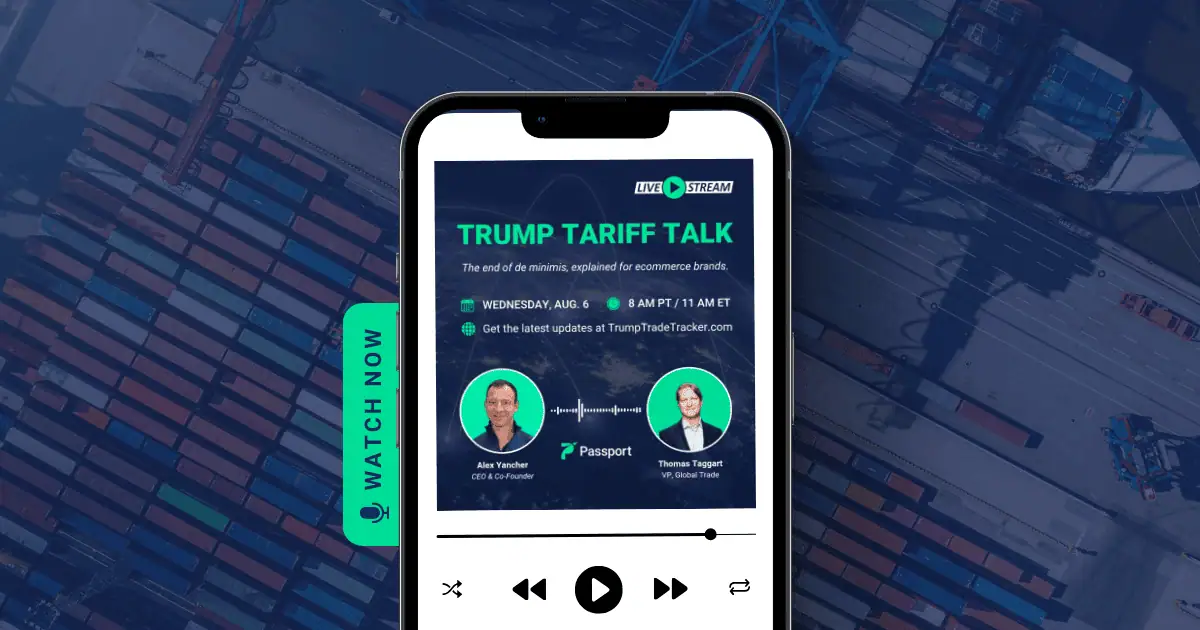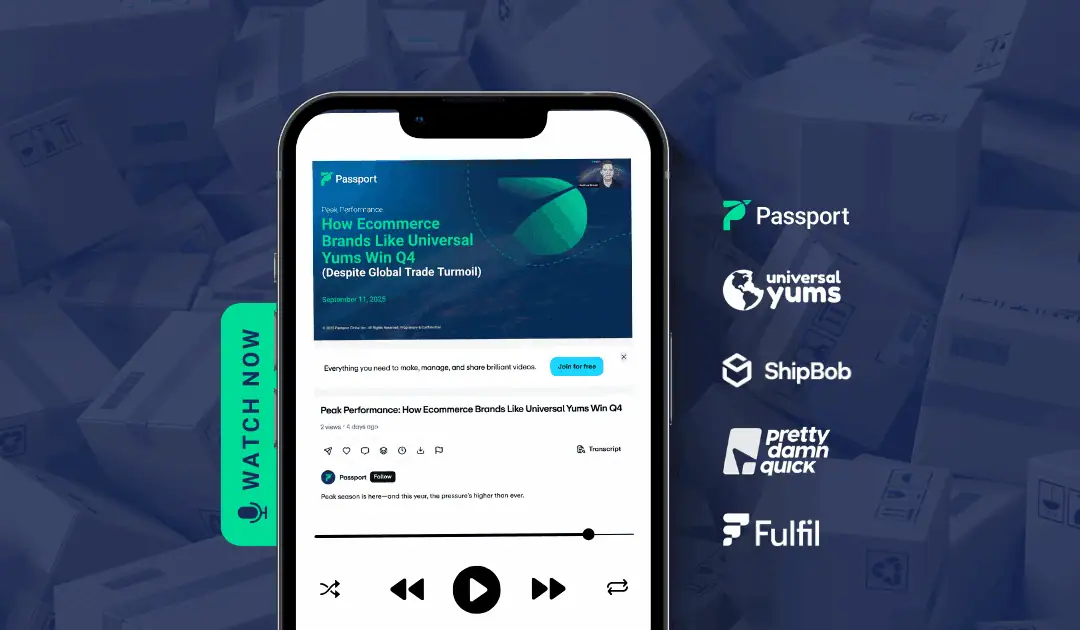On August 29, 2025, de minimis ends for all countries—not just China. This seismic shift in U.S. trade policy will reshape how ecommerce brands ship, price, and grow globally.
In our latest Trump Tariff Talk LIVE webinar, Passport CEO & Co-Founder Alex Yancher and VP of Global Trade Thomas Taggart broke down what brands can expect and how to prepare before peak season hits.
📺 Watch the full webinar on-demand here:
Here’s a quick recap of what was covered—including audience questions and the steps you should take now to stay ahead.
Why This Matters
De minimis is a trade provision that allows low-value imports to enter a country without paying duties or taxes. In the U.S., the de minimis threshold was $800, meaning shipments valued below that amount could be imported duty-free and with minimal customs documentation.
Its repeal means that starting August 29, every shipment, regardless of value, will be subject to duties and tariffs—with rates now stacking depending on country of origin.
“There’s no silver bullet anymore. You need a proactive strategy—or risk falling behind.”
Key Updates from the Webinar
Tariffs Are Rising—And They Stack
- China and Hong Kong: Up to 30% combined tariffs (including fentanyl-related surcharges)
- EU: 15% minimum tariff, not stacking—for now
-
Canada & Mexico: Mostly exempt under USMCA, but some U.S. goods face 25% surtaxes
-
India: Newly imposed 25% tariffs due to geopolitical tensions
-
Mexico: Imports from outside US/CAN now face a 33.5% VAT
You can view updated tariff tables by country at TrumpTradeTracker.com
A Quick History of De Minimis: From 1930 to Today
Before it became a hot topic in global trade policy, de minimis was a quiet line item in the U.S. Tariff Act of 1930.
- It was designed to avoid collecting duties on goods so low in value that the cost of enforcement outweighed the revenue generated.
- The original threshold: $1 in 1938.
- Over the decades, it gradually increased—most notably to $200 in 1993 and then to $800 in 2016 as part of the Trade Facilitation and Trade Enforcement Act (TFTEA).
This increase, along with simplified entry methods like Type 86, opened the floodgates. By 2023, 1.4 billion de minimis shipments entered the U.S.—mostly from China.
But increased volume brought increased risk: counterfeit goods, fentanyl shipments, and origin fraud prompted bipartisan calls for reform. In response, the Trump administration began rolling back the exemption country by country, culminating in a full repeal effective August 29, 2025.
As Tom noted in the webinar:
“It’s being positioned as a loophole or a scam now—but it’s been in the books for nearly a century. What’s changed is the scale—and how it’s been used.”
What’s Changing with De Minimis
- Ends August 29 for all countries
- Applies to both commercial and postal shipments
- Postal carriers may refuse to ship to the U.S. altogether (as China Post and Hong Kong Post already have)
- Postal vs. Commercial:
- Postal rates will apply a flat country-of-origin tariff
- Commercial entries may stack multiple tariff types (base, reciprocal, punitive)
Audience Q&A: Hot Topics Covered
The live audience had sharp, practical questions—two of the most common were:
How will transshipments be treated under the new rules?
Many brands asked: If goods are routed through an intermediary country before reaching the U.S., will that change the applicable duty?
Tom clarified: Not necessarily. U.S. Customs is focused on the true country of origin, not just where the package was shipped from. If CBP suspects that goods were “origin washed”—e.g., shipped from China to Vietnam and relabeled—they can apply an additional 40% punitive tariff on top of existing duties.
“Unless there’s substantial transformation, the original country of manufacture still applies,” Tom explained. “And CBP has made it clear: they’re watching for transshipment abuse.”
Is there still time to switch to local U.S. fulfillment before BFCM?
Yes—but don’t wait. Alex emphasized that many 3PLs are ready for this shift, and airfreight can get your inventory into a U.S. warehouse in a matter of weeks.
“There’s not plenty of time, but there’s enough time,” Alex said. “We can get you set up with a U.S. 3PL and local fulfillment—fast. We’ve been preparing for this for over a year.”
What Ecommerce Brands Should Do Next
Thomas and Alex laid out a detailed plan for navigating the end of de minimis and preparing for peak season:
1. Rethink Your Fulfillment Approach
If your business relies heavily on postal cross-border shipping, it’s time to rethink your model.
The most strategic move for many global brands? Shift to local fulfillment in key markets like the U.S.
- Import inventory into the U.S. ahead of time
- Pay duties on cost of goods sold (COGS)—not retail price
- Fulfill orders domestically for faster delivery and simpler returns
Testing commercial carriers like Passport now ensures you’re not scrambling come peak season.
2. Evaluate Your Pricing Strategy
With duties now unavoidable, pricing strategy becomes critical.
You’ll need to decide: pass the cost to customers, absorb it, or strike a balance?
- Analyze margin impact carefully
- Be transparent—clearly communicate duties and taxes at checkout to avoid surprise fees and cart abandonment
- Consider whether to build landed cost into your prices for a more seamless customer experience
3. Optimize Customs Valuation
Every shipment now requires proper customs clearance.
Incorrect valuation can lead to delays, audits, or fines.
- Use accepted valuation methods like transaction value
- Exclude non-dutiable costs (like shipping to the U.S.) from your declared value
- Work with a licensed customs broker to ensure accurate declarations and avoid overpaying or underpaying duties
4. Prepare for Regulatory Scrutiny
Customs enforcement is getting stricter. U.S. CBP is already increasing audits—and every shipment now requires an Importer of Record (IOR).
- Avoid risky tactics like undervaluation or misclassification
- Ensure your IOR is experienced and accountable
- Expect more visibility, more paperwork, and more oversight—especially during peak season
5. Consider Duty Drawback
If you re-export products or hold unsold inventory in the U.S., you could recover up to 99% of duties paid.
- Duty drawback is a powerful tool to offset rising costs
- Requires accurate documentation and a disciplined process
- Passport offers full-service support for eligible brands through our licensed customs brokerage
6. Evaluate Your Product Assortment
Not every SKU will stay profitable under the new duty regime.
- Review your product mix for U.S. fulfillment
- Prioritize high-margin products and those with lower duty rates
- Consider scaling back on SKUs with high tariff exposure
7. Review Classifications and Explore Tariff Engineering
Correct HS classification is essential—but smart brands go one step further.
- Review your current classifications for accuracy and compliance
- Explore tariff engineering: legally modifying products to qualify for lower duties
- The biggest retailers have been doing this for decades—now, mid-sized brands can too
Need Help Making the Switch?
Passport is built to help brands thrive in a post–de minimis world. We offer full-service solutions that combine logistics, compliance, and strategy to keep you growing—even in the face of rising tariffs.
Here’s how we can support you ahead of peak season:
- Set up local fulfillment in the U.S., Mexico, the UK, and beyond through our turnkey In-Country Enablement solutions
- Build a hybrid cross-border + in-country strategy to reduce duties, speed up delivery, and protect your margins
- Recover up to 99% of duties paid through our Duty Drawback program
- Ensure proper classification and documentation with hands-on support from our team of licensed customs experts
- Stay fully compliant and up-to-date with evolving trade and tariff rules—no guesswork, no risky shortcuts
Need support before BFCM? 👉 Request a demo to get started with a global strategy built for your brand.










